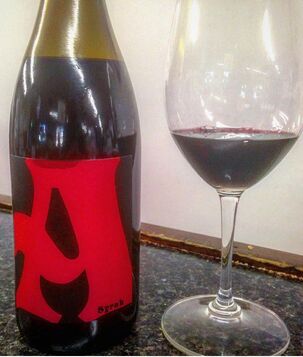 The Alfaro Family Vineyard & Winery sits near the top for us of a very short list of California producers that are still 'true' family run wineries and are still capable of delivering tremendous values. For over 20 years the family has owned and managed great parcels along the Santa Cruz Mountain chain, which in and of itself is often overlooked in California as one of the great sources for cooler climate influenced wines. The heavy fog blanket that rolls dramatically over the mountains on an almost daily basis cools the air and limits sun exposure, a huge contrast to the Santa Clara Valley below. The vineyards through here are scattered as optimum growing sites compete with real estate development and Forest conservation. Not much bulk wine available for making more value oriented wines, yet somehow Alfaro cobble together delicious, distinctive wines through their 'A' label series, even if it's only a few hundred cases at a time. This Syrah is borne from two parcels under the family's control, one of which is the source for their own single vineyard bottling and sold to other wineries for their own higher end projects. This is not a 'lesser' wine by taste, only by price. A deep ruby color, from the first pour the aromatics of the wine show off the Northern Rhone inspirations with cool, smoky cherry, cracked black pepper, and raspberries off the vine. Minimal barrel aging gives only a tinge of toastiness to the nose, allowing the natural savory dark fruit of Syrah to shine through. Also as inspired by the wines of Crozes-Hermitage and St Joseph in the Rhone, the cooler temperature keeps the alcohol and weight of the wine down, letting the palate deliver the same savory character as the nose without any sweetness or alcoholic burn. The bright acidity even delivers a bit more gamey/bloody note and tartness to the dark fruits, and the surprisingly fine tannins are given extra texture from the wine being bottled unfiltered. This impressive, succulent red has lots of potential life ahead for those that like a bit more elegance in their Syrah, but at this price you can be impulsive and pull this for any great cookout or tailgate celebrations ahead when the meat is as good as the company.
0 Comments
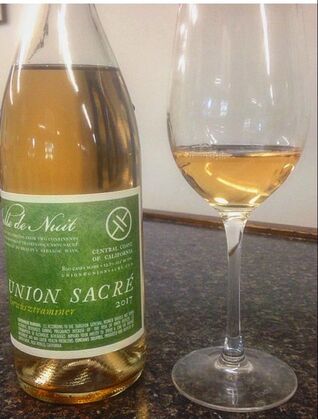 The concept of 'skin contact white wines' is embraced by a lot of consumers as a 'new' trend that follows along with the naturalist wine movement, walking hand in hand with the more funky wine flavors. Truth be told, skin aging is traditional for many wine regions and varieties, you just notice it with your palate instead of your eyes. The grape skin is where the natural tannins exist, as well as the pigment to color the wine. Chardonnay has no pigment, for example, so you may not notice how many white Burgundy wines have skin contact involved until you taste them. There are also some grapes that have a slight pigment to them, and only when fully ripe, so you find a lot of examples of white wines without any or minimal skin contact. Pinot Gris and Gewurztraminer both fall into this category, and while the rusty color wines are enjoying a resurgence, they always existed to an extent in places like Alsace and the cooler alpine regions of Italy. Fresh new eyes on these old styles make for exciting wines like this from store favorite Union Sacre, notoriously tinkering with small batches of California fruit from lesser known vineyards to make some fascinating juice. Slightly copper colored (in a shiny penny way, not a dirty water way), the aromatic is pretty obviously Gewurztraminer with loads of wildflowers, ginger and spicy tropical fruit. The palate is rich and mouthfilling, but FAR from sweet; the 'sweetest' thing about this wine, in fact, is the 'peek-a-boo' style tattoo label only seen through the back of the clear bottle. Pretty awesome. The actual residual sugar level is quite low, and the skin contact brings out some tannic dustiness and quenching citrus pith to the finish. Very few domestic Gewurztraminers veer as far from the tropical sugar water model as this does, much more emblematic of a Cru Alsatian or a top Alto Adige producer. The nose says to pair with spicy Asian dishes, but the drier palate also gives room to rich or savory pork and poultry as well. 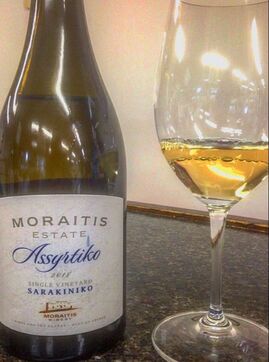 In a month or so, when Labor Day has passed and we are looking Fall fully in the face, many will start dreaming again about vacations on exotic beaches on far away islands (unless you are a big fan of Fall and love the cool temps and changing of the leaves, in which case you're all in). The Greek islands are a popular destination worldwide for island lovers, especially the group known as the Cyclades, known for equal parts beauty, history, and cuisine. These islands share similar soils and environment, so it isn't a surprise that the grapes used for winemaking are shared as well. Everyone wants their Assyrtiko white wine to be from Santorini or Mykonos because that is where they visited and had the most memorable times, but great versions exist across the island chain like this one from Paros. While a lesser known part of the Cyclades, the wines here are among their best, and this single vineyard bottling sits among the best examples from the island. Named for the famous Paros beach that sits just below the vineyard, the Sarakiniko site has unique volcanic soil that brings low ph but infuses the wines with intense natural minerality. The Assyrtiko grape is naturally high in acid so it doesn't need any help getting there from the soil. White there is a touch of grassiness on the nose similar to Sauvignon Blanc (the grape Assyrtiko is most commonly compared to), the aromas are more warm white fruit, sea spray and wet rocks. Many versions of the grape along the Cyclades can run off-dry to fairly sweet (to lure in the tourist like the Siren's song), this example is quite dry, bursting on the palate with full zesty white fruit, citrus skin, piercing mouthwatering acidity and a lengthy tingly finish. The richness and complexity born from the single site puts this well beyond the basic cocktail white, built for oily Mediterranean cuisine or pork/poultry with lots of garlic and herbs. 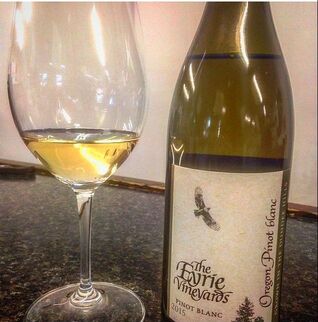 Pinot Blanc originated in Burgundy, according to lore, as mutations of Pinot Noir that would happen at random in the vineyards. Once the vines changed from red to white, that vine and and grafts cut from it would forever be white, and over time Pinot Blanc came into being in France and eventually appeared across much of Europe (also called Weissburgunder). In most places it is looked at as more of a workhorse grape going into blends or sparkling wines because of its high natural acidity, but every once in a while you can find a producer that prizes their parcel a little more than others. Eyrie Vineyards is the oldest of the Old Guard in Oregon, planting their first vineyards in 1965 and still possess some of the oldest Pinot Noir and Pinot Gris vines in the country. While Pinot Blanc was not among their earliest plantings, it is well established in several parcels among their Dundee Hills vineyards and considered on the very short list of Pinot Blancs made outside Europe. Pale in color and fairly quiet aromas in the glass at first, with soft peach and pear fruit with some orange citrus tones initially, with some time open there can be a bit of spice and slightly richer fruit emerging. In general, though, Pinot Blanc main appeal isn't a big perfume; we will leave that to the Gewurztraminers and Pinot Gris of the world. The palate is where the variety stands tallest, loaded with quenching acidity over the tangy stone fruits and a mouthwateringly long finish with endless prickles of zest and melon skin. The age of the vines and the lengthy lees aging is quite evident, and truly necessary, providing vital fruit texture in the mouth that would leave the wine a bit shrill if it wasn't there. Acid fans will love this, but it won't scare away too many fans of fruit forward wines either. A great Summer treat to pair with fresh fish and seafood dishes without too much weight or briny tones, like trout, catfish, or your more simply prepared white fish fillets. 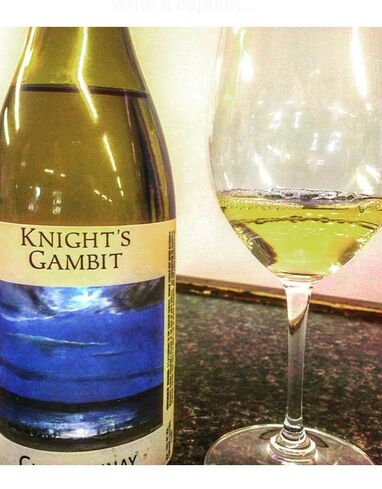 Sometimes Virginia wineries are looked at in a negative light for making very similar cookie cutter style wines. It can be difficult to venture too far away from what 'sells' in order to try something even a little outside the norm. But different can result in a move to something better, especially for a smaller winery trying to stand out. When we tasted on this most recent vintage of Chardonnay from Knight's Gambit, produced from fruit off their estate near Lake Albemarle, we were struck by how much of a Burgundian influence it carried. A reserved hand on the oak treatment is at odds with the usual route of oaky/buttery style looking to emulate the Californian prototype. Now while we don't have the soil types to bring out the vibrant minerality of say a Chablis or the subtle nuances of Meursault or Montrachet, the the warmth and zest of a quality Maconnais is fully proper and this wine takes on that style extremely well. From the first pour there is lots of aromatic white fruits and zesty citrus on the nose with only the slightest hint of toasty barrel, nothing that needs time to 'blow off' as the wine opens up. Lots of freshness and energy here that speaks of warmth without getting into the tropical or sweeter fruit characters, and the energy carries over to the palate as well. There is a roundness here, but not from a buttery weight that saturates the palate, instead from purity of the fruit that gives loads of fresh citrus and clarity to the finish. This is the wine you want to take to friends that don't want to try wines from Virginia because they've had 2-3 and think they know what they are all about. Prove them wrong! |
The Best of the Best.We offering free tastings on these wines in the store every Thursday and Friday, and a 10% discount off the retail price through the duration of the day. Come on by and give them a try! Archives
July 2024
Categories |
Location |
|

 RSS Feed
RSS Feed